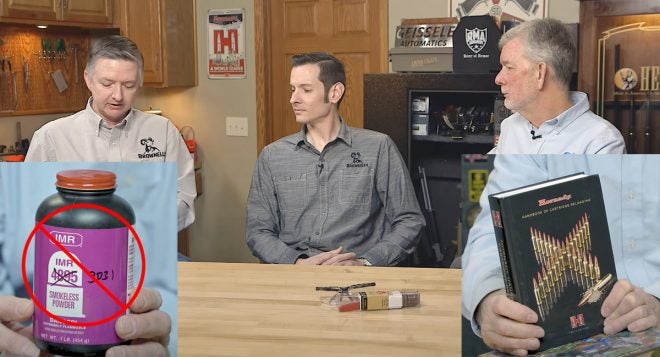Want to Get Started Reloading? Here are some Tips
Russ Chastain 12.28.20

(Image: Screenshot from ‘tips to get started reloading’ video)
In this Brownells “Quick Tip” video, three of their “gun techs” talk about how to get started reloading — more specifically, some things anyone should know before he or she sets out to begin reloading or handloading ammunition. Here are some highlights:
- Get a manual — or more than one. Using loads you find online can be hazardous, but loads from a manual have been tested under controlled conditions and are proven safe in the test guns, which are usually described therein (barrel length, etc).
- A load that’s safe in your buddy’s gun may not necessarily be safe in yours. Always start on the low end of the spectrum — paying attention to minimum loads so you don’t end up like this guy whose weak loads lodged 7 bullet in his revolver’s barrel — and work up if you want or need something hotter. As you go, be on the lookout for signs of high pressure.
- Even the brass you use can cause variations in pressure; some of it is thicker, so it will have a smaller volume (interior space)… which means a given load in that brass will generate greater pressure & velocity than the same load in lighter brass.
- NEVER mix powders! Always use only one type of powder at a time, and always stay within specs found in loading manuals.
- Keep your powder in its original factory-marked container. The manufacturer chose that container for safety, and the marking is really important.
- Designate a powder storage area for your containers of powder, and only get one container at a time out of that. Then, if you forget to dump the powder out of your powder measure as soon as you’re done reloading (which you really should do), you will know the powder in the measure belongs with that one container that’s not in the designated powder storage area. (This tip is one of mine.)
- Don’t measure case length before you remove the primers from brass.
- Powder should be stored in a climate-controlled space. The classic “cool dry place” is best.
- Always wear eye protection while loading ammo.
- Get a bullet puller and a stuck case remover, because mistakes happen.
- Always keep good notes about your loads, what you loaded and when, how each load performed, etc. This is invaluable when you walk away from the loading bench for a while and return, and you need to know where to start.
- Keep your work area clean, uncluttered, and well-organized.
- Minimize distractions while loading ammo.
And those are a few of the many things you need to know before you get started reloading ammunition. Enjoy the video, and safe shooting!